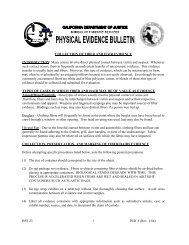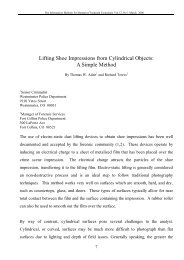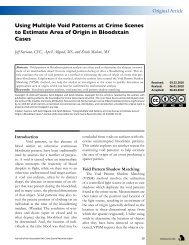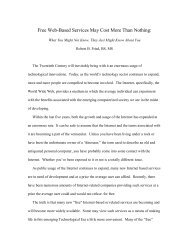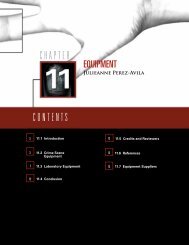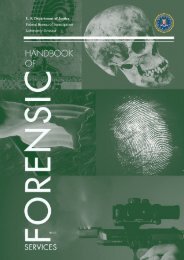PHYSICAL EVIDENCE MANUAL - Crime Scene Investigator Network
PHYSICAL EVIDENCE MANUAL - Crime Scene Investigator Network
PHYSICAL EVIDENCE MANUAL - Crime Scene Investigator Network
You also want an ePaper? Increase the reach of your titles
YUMPU automatically turns print PDFs into web optimized ePapers that Google loves.
Physical Evidence Manual<br />
Examine and take note of the following. It may help to divide the interior into<br />
quadrants and search each quadrant from ceiling to floor.<br />
• Examine exterior of vehicle. Look for transfer evidence relevant to the<br />
case (e.g. paint from a hit and run vehicle, clothing impressions on the<br />
plastic of a front bumper, hair caught on the broken edge of windshield<br />
glass, etc.).<br />
• Tire information for all tires including manufacturer, type, size, and tire<br />
pressure. Make an exemplar from each tire if it will be needed to compare<br />
to tire track evidence. 5<br />
• Position of seat(s), tilt wheel, and rear view mirror.<br />
• Condition and position of windows (broken, rolled up/down, etc.).<br />
• Vacuum or tape lift each quadrant for trace evidence. 6<br />
• Examine interior of vehicle.<br />
• Examine engine compartment<br />
• Examine trunk<br />
• Examine undercarriage of vehicle<br />
• Take known standards from the upholstery, carpet, or other vehicle for<br />
possible later comparisons if needed.<br />
Postmortem Examinations<br />
Photograph the following:<br />
• Full body photographs of victim as delivered to the postmortem<br />
examination.<br />
• Full body photographs of victim unclothed, before and after clean up.<br />
• Mid-range and close-up photographs of exterior wounds and/or identifying<br />
marks (e.g. tattoos) with and without a scale.<br />
• Photograph any body parts or evidence requested by the Medical<br />
Examiner (e.g. bullets, bullet tracks, etc.).<br />
It is recommended that the following evidence be collected during a postmortem<br />
examination. Remember that the postmortem examination may be the only (or<br />
last) chance to collect this evidence, so it is prudent to collect more than you<br />
think you need, rather than less, in these situations.<br />
• Blood standard. Collect at least one lavender/purple stoppered tube for a<br />
DNA standard.<br />
• Blood sample for blood alcohol determination. Collect at least one gray<br />
stoppered tube.<br />
5 See “Footwear and Tire Tread Evidence – Exemplars and Standards.”<br />
6 See “Fiber Evidence – Collection of Fiber Evidence.”<br />
Adopted: May 2002<br />
Revisions: 6<br />
Last Revision: January 31, 2008<br />
8-9



